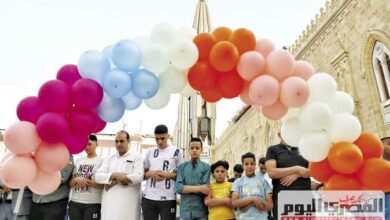In Egyptian Arabic, when referring to someone according to the work they do, people use a Turkish suffix rather than an Arabic one: inserting the letters “gy” at the end of the name of either the location or the product of their work to turn the word into the name of the career itself. That is why qahwagy means the man from the cafe and arbagy refers to the owner of horse-drawn carts. Therefore, when you say khayamgy, you are referring to someone who makes tents. The plural of khayamgy is khayamia–again, Turkish grammar–and that is also the name of the street in the al-Hussein area where all the tent makers in Cairo have their shops.
The street, deep in the Ghoria district in al-Hussein and only a few meters away from Bab Zuweila, is a traditional-looking market covered with a vault which gives it a calm atmosphere. As you walk down the quiet souq you will be dazzled by the beautiful and vivid colors of the fabrics sold in the various shops, and hear the different cries of welcome from the vendors, pulling out their finest pieces and unfolding them before your eyes and promising you the best prices.
There are many interesting traditions associated with the art of khayamia. Lead by the eldest worker in this career–Sheikh al-San’a, as they call him–each new person interested in joining the Khayamia district has to invite the heads of the workers to a lunch or dinner, where he presents some of his work hoping for their approval.
“They would present him with a gift if they approved his request to join the profession,” says Mahmoud Mohamed Hassan, who has been working in Khayamia for the last 17 years. He inherited his shop from his father and his grandfather before him. “Those were the good times, now anyone can join our trade, and honestly, the new people, who know nothing about our industry, are ruining our line of work for the rest of us.”
As the Arabic saying goes, the street is ‘deserted by footprints’–meaning that the place is empty– at the time of my visit, a number of children sitting sleepily in the shops surrounded by the different fabrics and watching Ramadan dramas on TV. Most of the shop owners won’t show up beforeiftar now, as most of the people looking for Ramadan tents bought what they needed before the start of the holy month.
Tarek Fattoh, however, was working on a beautiful dark blue piece when I entered his shop. The artist, who has been in this career for the last 30 years, recalls earlier times in the street. “Khayamia used to be the place to purchase all the tents and saradiq (a certain type of tent used during funerals),” Fattoh says. “Now, the place offers lots of other products like bed sheets and table cloths, pillows and even small pieces to hang on the walls.”
The artists, early in the last century, used only four colors in making the fabric, “Red, green, yellow and blue used to be the only colors used in our art, because they are happy colors,” Fattoh adds, “now we have different models and colors to suit different home decor.”
“The art produced by khayamia is one of the cheapest Egyptian traditional arts, although it is one of the most difficult,” Fattoh says with a proud look on his face, “It needs a lot of concentration. It involves a lot of talented work and needs a sharp eye to create it.”
According to Fattoh, one small piece of the beautiful fabric, if handmade, might take up to ten hours of continuous work, but the resultant income is hardly worth that amount of effort, especially with the new technologies introduced by the recent wave of workers. Many of the khayamia have decided to turn their business into factories, where they use machines to print the beautiful drawings on the fabric instead of using appliqué to add the little pieces of colored fabric by hand one after the other to create the final product.
“These machine-printed pieces are just ink on fabric, and if it gets washed the print will easily fade away,” says Fattoh, who refrains from using such methods in his work, “while the handmade work is appreciated by a certain group of people who understand the beauty and the effort put into each piece.”
The khayamia fabric is not only to be found in the street of Khayamia anymore, as the beautiful prints are can now be seen in the fashion shows of new Egyptian designers. Feelings towards these new designers in the original district are mixed.
“New local fashion designers started to use our fabric in their creations, but we are not interested in adding this new line to our industry,” Fattoh explains. “It is hard for someone who is knowledgeable in one line of work to introduce other lines in areas they don’t fully understand.”
Hassan recalls visits from the local designers, who were interested in the Islamic and Pharaonic prints he offers in his shop. “They wanted to take these prints and use them on T-shirts and galabiyas,” Hassan says. “They never tell us that they are going to use our products in their designs. They buy them like any other regular customer.”
This angers Hassan, as he believes that these drawings are trademarked by khayamia. “Elder people in our street drew these paintings,” he explains, “these people don’t ask for our permission to include our prints in their designs. If I knew they were going to steal our efforts, I would have never sold them anything.”
Overall, the art of khayamia is facing many challenges in today’s world, and the possibility of losing the origins of the beautiful fabric are significant.
“Without the support of the Ministry of Culture, I expect this art to become extinct.” Fattoh says. “Foreigners are the ones that reintroduced this form of art to back to the Egyptians.” Fattoh sends a plea for help out to any government-based organization to help revive the art by organizing annualkhayamia exhibitions. He believes that this is the only way to save the art from disappearing from the Egyptian markets.
Saeed Mokhtar, one of the oldest khayamia in the street, has found a different way to survive these new challenges. His son started to redirect their business to create Ramadan lanterns and bathroom towels using the same traditional fabric and the same prints. While his son believes that this is the future of khayamia, his father sees the new direction in a very different light.
“I don’t want to take part in these new modernized techniques,” he says bitterly, “this profession now includes people who used to be chicken and cheese sellers.” He takes a minute and shakes his head before saying “this career is almost dying.” The old man can’t help his anger and screams in my face, “Bedahya! (Good riddance!)”.




